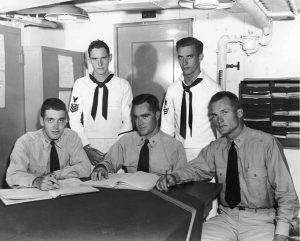Down To The Sea
An Epic Story of Naval Disaster and Heroism in World War II
 Buy the Book: Amazon, Apple Books, Barnes & Noble, Books-A-Million, IndieBound, Kobo
Buy the Book: Amazon, Apple Books, Barnes & Noble, Books-A-Million, IndieBound, KoboTitle: Down To The Sea: An Epic Story of Naval Disaster and Heroism in World War II
Published by: Collins
Release Date: 11/04/2008
Pages: 368
ISBN13: 978-0061173172
OVERVIEW
This epic story opens at the hour the Greatest Generation went to war on December 7, 1941, and follows four U.S. Navy ships and their crews in the Pacific until their day of reckoning three years later with a far different enemy: a deadly typhoon. In December 1944, while supporting General MacArthur’s invasion of the Philippines, Admiral William “Bull” Halsey neglected the Law of Storms — the unofficial bible of all seamen since the days of sail — placing the mighty U.S. Third Fleet in harm’s way. One of the most powerful fighting fleets ever assembled under any flag, the Third Fleet sailed directly into the largest storm the U.S. Navy had ever encountered — a maelstrom of 90-foot seas and 160-mph winds. More men were lost and ships sunk and damaged than in most combat engagements in the Pacific. The final toll: three ships sunk, 28 ships damaged, 146 aircraft destroyed, and 756 men lost at sea.
In all, 92 survivors from the three sunken ships (each carrying a crew of about 300) were rescued, some after spending up to 80 hours in the water. Scores more had made it off their sinking ships only to perish in the monstrous seas; some from injuries and exhaustion, others snatched away by circling sharks before their horrified shipmates. In the far-flung rescue operations, Bruce Henderson finds some of the story’s truest heroes, exhibiting selflessness, courage, and even defiance.
GALLERY
PRAISE
“My father, Chief Petty Officer John E. Kreidler, was one of more than 700 men who lost their lives in the great Pacific typhoon of December 1944. In the war’s aftermath, very little came to light about the fate of these men, and their sacrifice was scarcely acknowledged. Now Bruce Henderson has written a book that will stand as the ultimate history of the men and ships that encountered this monumental storm at sea.”
—John D. Kreidler
“With a storm scene right out of The Caine Mutiny, Down to the Sea is a vivid, powerful drama of men and ships in time of war.”
—Evan Thomas, Newsweek magazine and author of Sea of Thunder
“World War II produced so many compelling stories that even students of that momentous conflict are apt to discover we’ve missed whole vital episodes. Down to the Sea, about a devastating 1944 Pacific typhoon that sank three destroyers and cost 756 American sailors their lives, is just such as eye-opener.”
—New York Post
“Bruce Henderson has produced a book that should sit proudly in the bookcase of any American. Get one for your favorite sailor.”
—Tin Can Sailors, National Association of Destroyer Veterans
“What stands out in Down to the Sea are those moments that transform the disaster into an epic of courage and sacrifice. This is a book for anyone who wonders what happens when a ferocious sea attacks a ship and her crew.”
—Naval History
“Because of Bruce Henderson’s skills as a historian and a tale-teller, in this book I learned how my father died. Far more important, I learned how he lived.”
—Greil Marcus, author of The Shape of Things to Come
AUTHOR'S NOTE
I first heard about the Third Fleet’s disastrous encounter with a typhoon in the western Pacific in December 1944 one day at lunch with a friend, John Kreidler. He told me about his father, whom he never knew, perishing during the storm when his ship, the destroyer Hull, sank in the storm, leaving John’s pregnant mother a young widow. Growing up, John heard few details about his father’s death. While conducting research, I discovered another dozen “Hull orphans.”
Drawing on extensive interviews with nearly every living survivor (two dozen of the 94 survivors were still alive when I started my book research) and rescuer, many families of lost sailors, transcripts and other records from two naval courts of inquiry, ships’ logs and action reports, personal letters, and diaries, I finally after two years had the material to write this story of one of the greatest naval dramas of World War II — but one few people know about — involving ordinary seamen as well as the most famous “fighting admiral” of his day: Bull Halsey.

